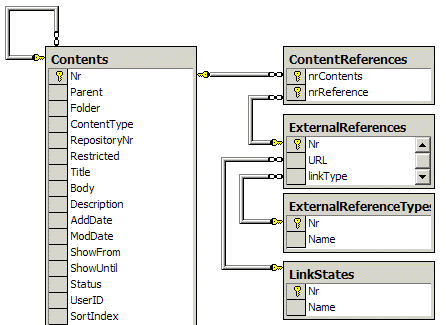Technical Overview
One of the core AIM tasks is the AIM scanning background process. This spider-like process scans data whenever content is added or updated, simply by requesting the item on the AIM channel.
DataModel
Rendering on the AIM channel produces an XML document with all outgoing AIM references, which are then stored in two separate locations:
- Cross-references are stored in the ContentRelations table, using reserved ContentRelationTypes:
- AIM
- AIMS
- AIMIF
- AIMFI
- AIMFF
- TRANSLATION
- External references (to resources not in the CMS) are stored in the ExternalReferences table using the ContentReferences table as cross-table.

The AIMState content field is used for housekeeping here: whenever the scan of an item is completed, the AIMstate field is set to Ready.
Scan Process
The AIM spidering process involves rendering items on the AIM channel, and is thus configurable en extensible by SXML site building. Building blocks include:
- AIM macro
Root macro for the AIM rendertemplate. Used to hold references collection during rendering and output it as XML - References macro
Embeds items on given channels in AIM-mode (using the Request Command hid=AIM) and adds the relations found during rendering to the collection in the root AIM macro.
Multiple calls are allowed to include channels on which the item renders and produces relations to other resources. - AIMScan macro
Scans the item's raw data for references, such as HTML hyperlinks.
Currently, the following references are detected by AIM:- HTML entities
- href (BASE, A, AREA, LINK)
- src (APPLET, BGSOUND, EMBED, FRAME, IFRAME, IMG, INPUT type=image, SCRIPT, XML)
- background (BODY, TABLE, TD, etc..)
- CSS entities
- @import (CSS include)
- url (CSS attributes)
- XML entities
- xml-stylesheet
- xsl:include
- HTML entities
- Several AIM helper Viper methods
aim.addrequest(), aim.references.add(), etc... - Many AIM-aware macros and Viper methods
Application, XLinks, SiteMap, Parents, Embed, EmbedUri, Siblings, ItemData, Html.Link(), Response.Redirect(), ItemData.Field(), etc...
A typical AIM RenderTemplate looks like this (1.3+):
| Smartsite SXML |
|
|---|---|
<se:xmlprocessor xmlns:se="http://smartsite.nl/namespaces/sxml/1.0">
<se:parameters>
<se:parameter name="xml">
<se:aim>
<se:aimscan
error="{buffer.set(scanError, this.error.message())}" />
<se:references
channel="{channel.defaultchannel()}"
error="{buffer.set(renderError, this.error.message())}" />
</se:aim>
</se:parameter>
<se:parameter name="actions">
<se:collection>
<se:member query="//references">
{sys.iif(buffer.exists(renderError), this.setattribute(renderError, $renderError) )}
{sys.iif(buffer.exists(scanError), this.setattribute(scanError, $scanError) )}
</se:member>
</se:collection>
</se:parameter>
</se:parameters>
</se:xmlprocessor>
|
|
Cache- and state-invalidation
When content changes occur, Smartsite iXperion uses the SQL function fn_RecurseAIMDependencies() to collect the dependencies of the changes:
| SQL |
|
|---|---|
select nr from dbo.fn_recurseAIMDependencies(?, 0) |
|
The fn_recurseAIMDependencies() function collects the complete chain of AIM relations given one or more item numbers:
| SQL |
|
|---|---|
select a.depth, a.nr, c.title from dbo.fn_recurseAIMDependencies(238, 0) a join vwContent c on a.nr=c.nr order by a.depth |
|
Will return a list of all items directly or indirectly affected by changes to item 238.